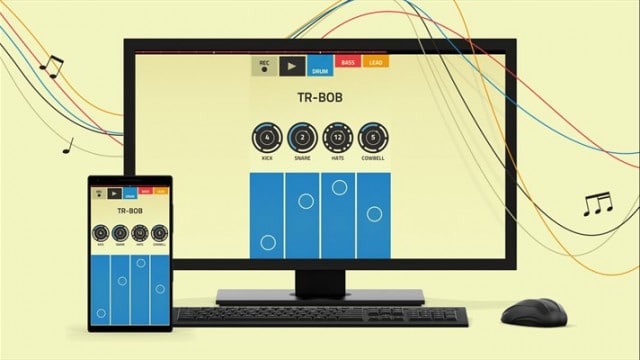While Windows 10 still does not have as many apps as its biggest competitors, it has become home of some very interesting creativity apps. There’s Staffpad that lets you write music with the Surface Pen, there’s Sketchables – a powerful art-making app, and then there’s Figure, a stylish, minimalistic take on a virtual beatmaker. Figure got it start on iOS before being brought to Windows through the Universal Windows Platform (UWP), and the Windows Apps Team has published a post on the Building apps for Windows blog to discuss the app’s journey across platforms.
Figure’s developer, Propellerhead Software, is no stranger to Windows development, being a famous digital music software makers for the Windows desktop platform. Their first expansion outside of Microsoft’s operating system was Figure on iOS in 2012, which they brought back home a few years later, albeit with a completely new backend. Three important aspects of this transformation are discussed in the blog post: sound latency, UI development, and music sharing; all of which were readily fulfilled by the power of UWP.
“You want to get the latency between touch on the screen until you get audio out of the speaker to as low as possible,”
Magnus Berger, Propellerhead’s CTO and developer
Windows 10 reportedly made huge improvements under the hood regarding audio, which transfers to audio-related UWA. With the new variable audio buffer sizes and optimization, latency between user interaction and sound coming out can be cut down to 1/2 to 1/10 the default buffer time, creating for users the illusion that the audio changes are instantaneous whenever they modify the beat on screen. It certainly satisfied the seasoned pros at Propellerhead, who literally played it by ear for the testing.
Figure’s UI looks surprisingly suited to Windows aesthetics, but the design is actually very consistent with its iOS counterpart. To achieve this, the developers rewrote their entire UI in C++/CX – supported by UWP – and took advantage of the XAML Designer platform for the adaptive layouts necessary for a UWA. The result is a beautiful, fun, minimalistic and responsive app experience that works identically on both iOS and all Windows devices.
“If you do something in Figure on iOS,” said Leo Nathorst-Böös, Product Manager at Propellerhead, “you can pick up that song on a Windows device, and they’ll sound identical. And that goes for the cloud sharing that people can do. The Windows version just plugs into that community.”
A big part of Figure is also how users can share their musical creations, which Propellerhead easily achieved with UWP’s REST client – also used by the iOS app – and built-in JSON support. The same backend allows cross-platform sharing between iOS and Windows, and sharing to other people as well as different devices.
All in all, the UWP’s many capabilities have helped Propellerhead to bring a consistently awesome music making experience from iOS to Windows. Figure serves as a prime example of Microsoft’s strategy of courting over great iOS developers and apps. As the company continue to add to the UWP’s capabilities in the future, we hope to see many other polished experience like Figure populating the Windows Store.
Image credits: the Windows blog



